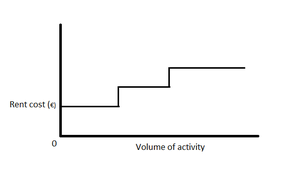Step fixed cost
| Step fixed cost |
|---|
| See also |
A step fixed cost is a cost that is determined within the scope of activity. It is not dependent on the size of the business thresholds. It changes when the threshold is exceeded. A key conceptual issue at a fixed cost is that they be established only within a specified scope of activity. If you go beyond this range, the cost structure will change significantly[1][2].
Conditions in regard to a step fixed cost
A step fixed cost varies within high and low business thresholds. When the cost changes the threshold, a new set of activity thresholds is used in which the fixed cost will not change significantly. This concept is good for making investment decisions in a company. A limit breach can result in one of two conditions in respect to a step fixed cost.
- Activity declines. Management has the option of deciding when the activity level will fall below the lower threshold level. For example, when the sales volume drops, you can sell the production line. In this way, all costs associated with it are eliminated. In this situation, the step fixed cost goes to a lower level.
- Activity increases. In this situation, management also has a choice. When the level of activity rises to the upper threshold, they can decide that they remain at the current level of step fixed cost. They can also accept an increase in activity and incur an additional cost. For example, when sales increase to their maximum level, management may maintain an step fixed cost and not take more orders. The second solution is accepting orders and increasing the step fixed cost to a higher level.
Example of a step fixed cost
The company has involved in significant foreign expansion. As a result, there has been massive increase in business. It turned out that the company is forced to open new offices because there is not enough. The changes will cause that the rental costs will no longer remain fixed. As the volume of activity increments from zero, the rent (a fixed cost) is unaffected. In any case, at a specific point, the volume of activity cannot increment without extra space being leased. The cost of renting the extra space will cause a 'step' within the rent cost. The higher rent cost will unaffected that volume were to rise advance, until another step point would be come to. The figure (Fig.1) shows how the rental cost will behave in the described example. This cost behavior is known a step fixed[3].
Step-cost function
“A step-cost function displays a constant level of cost for a range of and then jumps to a higher level of cost at some point, where it remains for a similar range of activity”[4]. In reality, thanks to the step-cost function it is possible to describe many of the step fixed costs. Many committed assets - especially those that include verifiable contracting - follow a step-cost function. Step-fixed costs are allocated to the fixed cost category, since most are settled over the firm's ordinary working range[5][6].
Footnotes
References
- Finkler S. A., Ward D. M., Baker J. J. (2007), Essentials of Cost Accounting for Health Care Organizations, Jones & Bartlett Learning, Sudbury
- Hansen D., Mowen M. (2014), Cornerstones of Cost Management, Cengage Learning
- Hansen D., Mowen M., Guan L. (2007), Cost Management: Accounting and Control, Cengage Learning, South-Western, USA
- Nobes Ch. (2014), Accounting: A Very Short Introduction, Oxford University Press, United Kingdom
- Walther L. M. , Skousen Ch. J. (2010), Cost Analysis: Managerial and Cost Accounting, Bookboon
Author: Monika Wójcik
